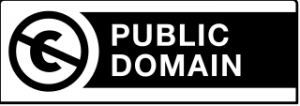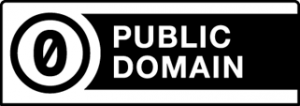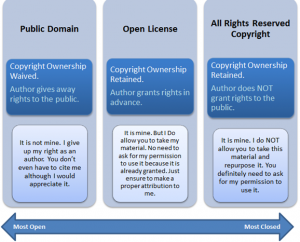6 Distinguish Between Materials That Are All Rights Reserved, in the Public Domain, and Openly Licensed
What is all rights reserved?
As outlined in the section What is copyright?, copyright grants to creators a bundle of exclusive rights over their creative works, which generally include, at a minimum, the right to reproduce, distribute, display, and make adaptations. The phrase “All Rights Reserved” is often used by owners to indicate that they reserve all of the rights granted to them under the law. [1] If a work is in copyright, you should assume “all rights reserved” even if this isn’t indicated.
What is the public domain?
A public domain work is a work that is not protected by copyright, which means it’s free for you to use without permission. Works in the public domain are those for which intellectual property rights have expired, have been forfeited, or are inapplicable.
Here are some examples of works in the public domain:
- Material created by the US Government, such as pictures taken by NASA
- Materials for which Copyright Protection has lapsed, such as Miles Franklin, My Brilliant Career
- Works released to the public domain by licence when they were created, such as images on Pexels
Determining if a work is in the public domain because copyright has lapsed or expired can be difficult because the terms of copyright protection in Australia have changed over time. See How long does copyright last? [2]
As well as copyright expiring, creators can relinquish copyright in their work to the public domain.
Creative Commons (the organization) created a legal tool called CC0 to help creators place their work as close as possible to the public domain by releasing all rights to it.[3]
You can identify these works by looking for the Public Domain Marks
Public Domain Mark

“Public Domain Mark” is licensed under CC BY 4.0
Creative Commons CC0 Public Domain Mark

“CC0” is licensed under CC BY 4.0
What is openly licenced?
Open Licences are a set of conditions applied to an original work that grant permission for anyone to make use of that work as long as they follow the conditions of the license. The copyright owner – usually the creator of the work – can choose to openly license their work if they want others to be able to use it freely, build on it, customize it or improve it. Open licenses therefore give permission to anyone to use the work at no cost, and generally allow anyone to modify the work with no or minimal restriction (such as attributing the original author’s work). There are several open licenses that follow these principles, among the most common are Creative Commons licences for written works, music, visual and other artistic expressions; and GNU General Public License for software. Exact conditions of open licences are available under the licence descriptions. [4]
You will be introduced to Creative Commons licences later in this part.
What is the difference between public domain and open licence?
They both grant free access to the materials, but the scope and nature are completely different.
Open licensing does recognise clear ownership of intellectual property and the work is still protected under copyright law, whereas works in the public domain are not protected by copyright law. Therefore, users are required to follow the licence requirements when using openly licensed materials.
This infographic below illustrates the differences between public domain, open licence, and all rights reserved copyright. [5]
Difference between open licence, public domain and all rights reserved copyright

“Difference between open license, public domain and all rights reserved copyright” by Boyoung Chae is licensed under CC BY 4.0
Why open licensing matters
The power of open licensing lies in its ability to clearly communicate how the creator intends the work to be used. A creator can explicitly share the work and control the licensing provisions while retaining ownership. Remember, for a work without a copyright notice, all rights reserved is assumed. If you want to openly share your OER with your students and peers at RMIT, or publish it online for the world to access, displaying an open copyright licence statement with the work ensures it will be easily and clearly adopted in the way you intend. [6]
- Creative Commons. (2021). Frequently asked questions. https://creativecommons.org/faq/ CC BY 4.0 ↵
- Gits, C. (2020). Texas Learn OER. https://sites.google.com/austincc.edu/texaslearnoer/ CC BY 4.0/ ↵
- Meinke, W. (2018). UH OER Training. https://pressbooks.oer.hawaii.edu/oertraining2018/ CC BY 4.0 ↵
- Adapted from.Year of open. (n.d). What are Open Licenses? https://www.yearofopen.org/what-are-open-licenses/ CC BY 4.0 ↵
- Gits, C. (2020). Texas Learn OER. https://sites.google.com/austincc.edu/texaslearnoer/ CC BY 4.0 ↵
- Gits, C. (2020). Texas Learn OER. https://sites.google.com/austincc.edu/texaslearnoer/ CC BY 4.0 ↵

